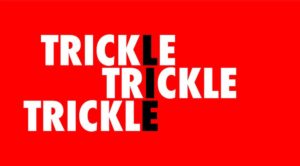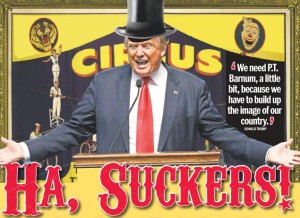Last week the nonpartisan Congressional Research Service (CRS) issued a report that makes it official: the “Trump tax cut bill,” the only legislative achievement of the previous Republican Congress, has not generated any meaningful new economic growth that was not already underway. And the crooks who passed it (above) are laughing all the way to their bank.
Think Progress reports, New study confirms ordinary Americans got fleeced by the Trump tax bill:
The new numbers inject further complexity into a contentious and ongoing debate around the landmark tax legislation as to who actually benefited from its passage. But the study should also offer additional clarity: With hard numbers now available on the economy’s performance in the first full year of the legislation, it’s easier than ever to talk instead about who got what and how — and the answers, so far, aren’t pretty.
 Large corporations with shiny accounting departments ended up being the largest beneficiaries of the tax bill’s largesse, with the rate of tax they actually pay dropping by half in 2018, according to the CRS analysis. But the vanishingly insignificant comparative break Trump’s law gave workaday people lays the game bare. This tax bill is already reshaping the real-world economy in ways that limit the prospects of ordinary people, potentially reinforcing the structural inequities that adversely impact democratic society.
Large corporations with shiny accounting departments ended up being the largest beneficiaries of the tax bill’s largesse, with the rate of tax they actually pay dropping by half in 2018, according to the CRS analysis. But the vanishingly insignificant comparative break Trump’s law gave workaday people lays the game bare. This tax bill is already reshaping the real-world economy in ways that limit the prospects of ordinary people, potentially reinforcing the structural inequities that adversely impact democratic society.
Trump and his congressional allies had forecast massive jumps in GDP growth and working-family incomes from the package. None materialized in year one. Annual growth hit 2.9% – identical to the 2015 mark, well below the 3.3% the Congressional Budget Office forecast when it sought to predict the tax bill’s impact in April of 2018, and right in line with what the CBO had predicted the economy would have done without Trump’s corporate-tax munificence.
The report’s findings underscore the deceitful nature of the administration’s first-term sales pitch.
Working people were supposed to benefit from the slashed corporate income tax rate and related rules tweaks intended to lure offshored profits back into the U.S. economy. American companies weren’t hiding $3 trillion in profit outside the country out of malice, the argument went. Rather, they were afraid of seeing it taxed too sternly, and would happily bring it home to make productive and equitable use of it just as soon as they felt it was safe from the taxman.
Some business heads dutifully followed this script in small and symbolic ways shortly after the law was signed, issuing year-end bonuses to their frontline employees and accompanying them with heavy fanfare in the press. But even the high-end estimates of those bonus payments account for less than 3% of the money corporate payers got handed back to them by the tax law. Those bonuses may have had as much to do with firms’ recognition that falling unemployment rates would make it easier for unhappy workers to leave for greener pastures, the CRS report notes.
So what happened to the other 97% of the money corporate accountants were handed by the government? A trillion dollars of it went to shareholders, as the law triggered a record wave of stock buybacks – an unproductive back-scratching activity that keeps the money firmly ensconced in upper-class hands that have little reason to spend that new cash back into the economy where working stiffs make their living.
This grand act of class solidarity between wealthy elected officials, wealthy corporate executives, and wealthy investors was entirely predictable. Corporate tax repatriation enticements and rates-slashing typically generate this kind of unproductive reshuffling of capital – thereby reinforcing the working class’s sense that they aren’t even being dealt into the hand.
Such stark differences in outcomes for the masses and the privileged few help fuel the populist anger that’s on the march across nearly every developed democracy on the planet.
Wages – a more stable indicator of how much wealth capitalists are allowing to pass through to their labor than any one-off bonus – offer no respite from the gloomy CRS diagnosis. Blue-collar wages rose just 1.2% in 2018 after accounting for inflation, the report’s authors found, which “indicated that ordinary workers had very little growth in wage rates.”
Out of every three taxpayers, roughly two owed the government less this tax year than they had prior to the new tax law. Many people who got a tax cut in year one appear not to have noticed, as the New York Times’ Jim Tankersley and Ben Casselman reported recently, because the annualized cut was spread across a year’s worth of paychecks instead of lumped together at year end.
 But whether working families noticed the new money or not, the combined effect of those modest middle-class cuts and the massive corporate giveaways that make up the bulk of the Trump tax law’s price tag were supposed to load the economy’s engine with high-octane juice. The working theory was that this “2 Fast 2 Furious” boom would rain new revenue down on the treasury with such swift thoroughness that the public would neither notice nor care that a large amount of its collective money got handed over to wealthy multinational companies. The cut, its proponents insisted, would pay for itself. [Faith based supply-side “trickle-down” GOP tax policy.]
But whether working families noticed the new money or not, the combined effect of those modest middle-class cuts and the massive corporate giveaways that make up the bulk of the Trump tax law’s price tag were supposed to load the economy’s engine with high-octane juice. The working theory was that this “2 Fast 2 Furious” boom would rain new revenue down on the treasury with such swift thoroughness that the public would neither notice nor care that a large amount of its collective money got handed over to wealthy multinational companies. The cut, its proponents insisted, would pay for itself. [Faith based supply-side “trickle-down” GOP tax policy.]
Note: In an insult to economic science and all that is good and holy, Trump is Giving a Medal Of Freedom To ‘Trickle Down’ Economist, ‘Trumponomics’ Co-Author Arthur Laffer, the “father of supply-side economics” and “trickle-down” tax fraud, and the notorious “Laffer Curve.” This sonuvabitch ought to be spending the rest of his remaining days rotting in a prison for the massive amount of harm that his tax fraud has caused this country and the lives of Americans over the past 40 years. Don’t get me started!
A year on, the tax bill is miles behind the trajectory required to make that promise plausible. The authors of the CRS study calculate that the tax law’s 2018 performance generated “5 percent or less of the growth needed to fully offset the revenue loss” in year one.
“Much of the tax cut was directed at businesses and higher-income individuals who are less likely to spend,” the CRS researchers wrote. “On the whole, the growth effects tend to show a relatively small (if any) first-year effect on the economy.”
That mathematically correct conclusion misses an important wider point about public policy choices. The bill has had a huge effect on what kind of economy we have, if not on the size of that economy as measured in the stats these analysts parse. Inasmuch as the costs of the bill could have been spent on other people if their government had made other choices, the tax law is redistributing wealth upward, providing the wealthy investor class a jolt of money they have no reason to spend.
Everyone else saw a relative pittance – enough money to make a difference to a working family, but a tiny fraction of the public money federal lawmakers chose to give to private companies and their shareholders through these changes – and none of the wider opportunity-sparking growth promised by the people marketing the bill 18 months ago.
The tax cut former House Speaker Paul Ryan (R-WI) put on Trump’s desk has subsidized the wealthy, just as the GOP intended.
Phillip Bump at the Washington Post adds, A new report further undermines Trump’s claim that the tax cuts were economic ‘rocket fuel’:
 Last month, President Trump revived one of his preferred descriptors for the tax cuts that he signed into law in December 2017.
Last month, President Trump revived one of his preferred descriptors for the tax cuts that he signed into law in December 2017.
“We promised that these tax cuts would be rocket fuel for the American economy, and we were absolutely right,” Trump said at a roundtable event in Minnesota.
He used that “rocket fuel” line before the tax cuts passed, too, pledging that the cuts would inject new energy into an already strong economy. Sure, independent analysis figured that the cuts would cause the deficit to spike. But Trump allies pledged that the cuts would spur so much economic growth that the bill would end up increasing tax receipts, as people and companies paid higher taxes on their higher incomes. Companies would bring money back from overseas and use the cuts to expand operations. The law would, in short, pay for itself, some proponents claimed, with the net effect of increasing wages and employment.
“At the heart of America’s revival are the massive tax cuts that I signed into law a year ago,” Trump said at an event for the National Association of Realtors in May. “And they are like rocket fuel for America’s economy.”
It’s a bit odd for Trump to claim that tax cuts signed into law in December of his first year in office are responsible for “America’s revival,” given that the unemployment rate dropped from 4.7 percent in January 2017 to 4.1 percent the month the law was enacted — and, 16 months later, is only at 3.6 percent. (Especially given that the decline has been fairly steady since 2010.)
It’s also a bit odd because while year-over-year economic growth has increased since the last quarter of 2017, it has been increasing since the second quarter of 2016.
But it’s particularly odd because analysis released this month by the nonpartisan Congressional Research Service shows that the effects of the tax law have been at best minimal.
“In 2018, gross domestic product (GDP) grew at 2.9%, about the Congressional Budget Office’s (CBO’s) projected rate published in 2017 before the tax cut. On the whole, the growth effects tend to show a relatively small (if any) first-year effect on the economy,” the report’s summary reads in part. “Although growth rates cannot indicate the tax cut’s effects on GDP, they tend to rule out very large effects particularly in the short run.”
That’s followed by a number of other “althoughs,” which serve as rebuttals to common assertions made by Trump and his allies.
 Although the economy did grow, the cuts came nowhere close to paying for themselves. “[T]he combination of projections and observed effects for 2018 suggests a feedback effect of 0.3% of GDP or less,” the report reads — “5% or less of the growth needed to fully offset the revenue loss from the Act.” In other words, 95 percent of the increase in the deficit wasn’t offset at all.
Although the economy did grow, the cuts came nowhere close to paying for themselves. “[T]he combination of projections and observed effects for 2018 suggests a feedback effect of 0.3% of GDP or less,” the report reads — “5% or less of the growth needed to fully offset the revenue loss from the Act.” In other words, 95 percent of the increase in the deficit wasn’t offset at all.
Although wages grew, they grew more slowly than GDP. “If adjusted by the GDP deflator, labor compensation grew by 2.0%,” it reads at another point. “With labor representing 53% of GDP, that implies that the other components grew at 3.8%. Thus, pretax profits and economic depreciation (the price of capital) grew faster than wages.” Put another way, companies saw a greater increase in earnings than workers did. Modest inflation-adjusted wage growth “is smaller than overall growth in labor compensation and indicates that ordinary workers had very little growth in wage rates,” the report states.
Although money was repatriated from offshore tax shelters, the money doesn’t appear to have been used for investment in expanding the companies. “[M]any factors can affect net capital inflows,” it reads, “including domestic borrowing by the government and domestic saving, but the evidence does not suggest a surge in investment from abroad in 2018.”
Although the repatriation and cuts occurred, “relatively little” went to the worker bonuses that Trump celebrated after the cuts were signed into law. “One organization that tracks these bonuses has reported a total of $4.4 billion,” the report states. “With US employment of 157 million, this amount is $28 per worker. This amount is 2% to 3% of the corporate tax cut, and a smaller share of repatriated funds.”
Put directly, the CRS report finds no justification for Trump’s dubious claims that the tax cuts served as a significant boost to the economy, much less played a central role in “America’s revival.”
The impression that’s given isn’t “rocket fuel.” In terms of apparent saturation, it was something more akin to “water poured onto concrete.”
Republican faith based supply-side “trickle-down” tax policy is and always has been a lie — George H.W. Bush was right when he called it “voodoo economics” — and yet too many Americans keep falling for it, time and again, to their own financial detriment. I guess it’s true that you can’t fix stupid.
Discover more from Blog for Arizona
Subscribe to get the latest posts sent to your email.

But you can fix ignorant. Good start, right here…